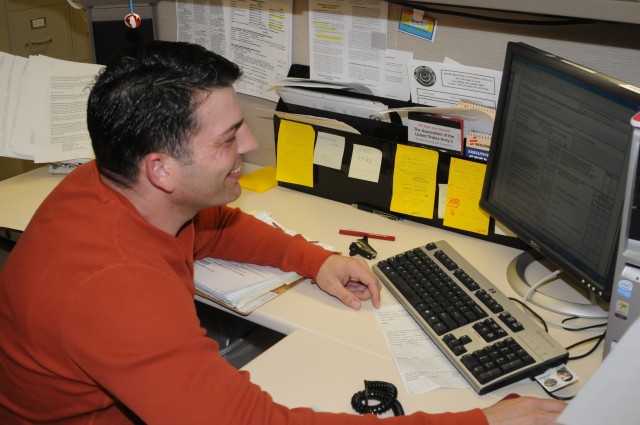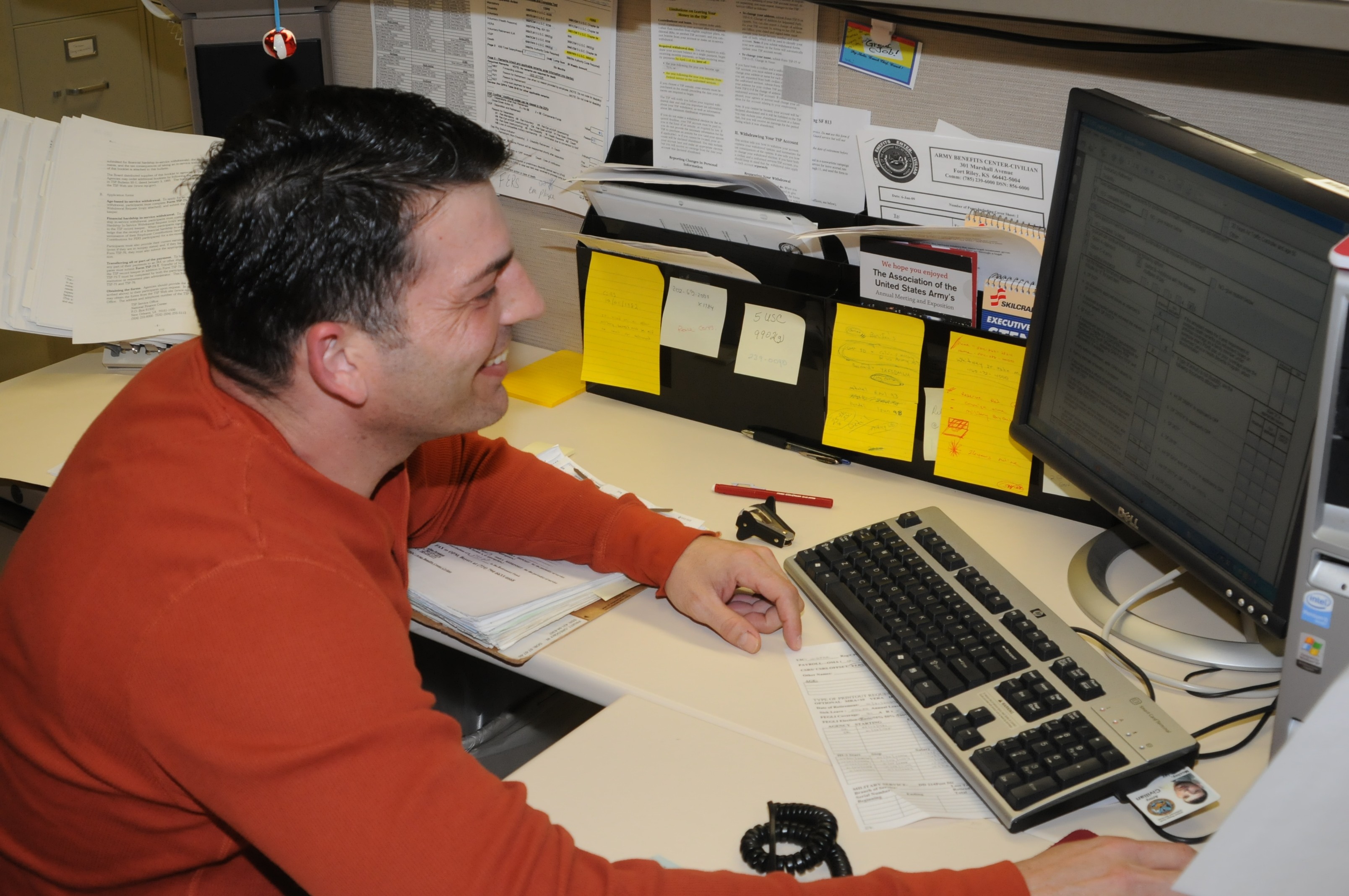FORT RILEY, Kan. - Calvin McCloy appears to be in his comfort zone, handling phone calls from civilian employees worldwide from his desk within Fort Riley's Army Benefits Center.
The former infantry first sergeant has been working as a civilian human resource specialist for nearly one year under a partnership program of the Army Wounded Warrior program, the Civilian Personnel Advisory Center and 1st Infantry Division's Wounded Warrior Battalion.
"We do benefits, estimates and retirements for all the Department of the Army civilian employees," said McCloy, who was wounded in a 2005 bomb attack in Iraq.
The West Virginia native began working at the call center while still on active duty. While assigned to the WTB, McCloy met Patti Walker, an Army Wounded Warrior, or AW2, advocate who linked him with Kelly Frazier, CPAC supervisory human resource specialist.
"Patti's the one that made the initial push and put the connection open between the CPAC and me," McCloy said. "She had me go down to CPAC and see Kelly Frazier. Then after talking to Kelly and with my resume, I ended up being placed here."
McCloy's civilian reentry coincided with that of Patrick Tutwiler, the first Soldier to go through the placement program. Tutwiler was wounded by sniper fire in 2007 while serving in Iraq. The former Army specialist also wore his ACUs to his job as a human resource technician early last year until he was medically discharged from service. Tutwiler works on background checks, appraisals and awards in his CPAC office.
"It's nice because I've been on this post for three years now," Tutwiler said. "I know my way around. If I have any questions or need any training, everybody here is more than willing to help me out."
Tutwiler also has become somewhat of a local celebrity after receiving a new home in Chapman, Kan., during a Jan. 25 episode of ABC's Extreme Home Makeover. Tutwiler and his Family were chosen by the network to be on the show because a tornado had destroyed their home and much of Chapman last June.
Driving the program from CPAC, Frazier said her work at Fort Riley has become a model for her higher headquarters, the Civilian Human Resource Agency at Aberdeen Proving Ground, Md.
"We're letting them (CHRA) know what's worked for us, and they're actually making a program at our headquarters for this," Frazier said.
She had the opportunity to talk about the placement program's success while attending the Association of the U.S. Army annual meeting and exposition last October in Washington, D.C. Frazier was accompanied by McCloy and Donald Laplante, another former Fort Riley Soldier who's found work in the program.
"We had the opportunity to tell our story," Frazier said. "They said there were seven AW2 placements made Army-wide and four of them were at Fort Riley."
Soldiers have a lot to offer their employers when they apply for civilian positions, Frazier said.
"It's their work ethic," she said. "They have a lot of the experience that supervisors are looking for. They can hit the ground running. Working with the military on the other side, they can sometimes roll right in and do the job."
Job placements may not always be a perfect match, so Frazier works with Soldiers on a trial basis called borrowed military manpower before making long-term commitments.
"We fill out a memorandum between the supervisor, the employee and their squad leader as far as them going over there and doing an internship. So if it didn't work out, then they wouldn't have to convert them to a civilian position," she said. "We've had a lot of success with the placements so far. The people that have been placed have worked out well for both the employee and the supervisor."
Not every wounded Soldier chooses to stay in the Central Flint Hills Region after receiving a medical discharge from the Army.
"For instance, if somebody says they're interested in going to Fort Leavenworth, and let's say they're stationed at Fort Riley, Patti (Walker) would send their resume to her headquarters AW2," Frazier said. "They would send it to my headquarters, which is CHRA, and they would task CPAC to find a position. So right now there is something in place in other CPACs, but it's at a broader level than what we're doing here."
Leaving Fort Riley was not an option for McCloy. Besides facing a tight job market during a recession, McCloy said his decision was based on what felt comfortable to him.
"I was already here at Fort Riley and familiar with everything here," McCloy said. "There are a lot of things I like about being here, like the people and the location. The main thing is I was just comfortable here."
The AW2 placement program is building up steam a year after its inception. In addition to her four placements, Frazier currently is trying to place seven more wounded warriors in jobs on post.


Social Sharing